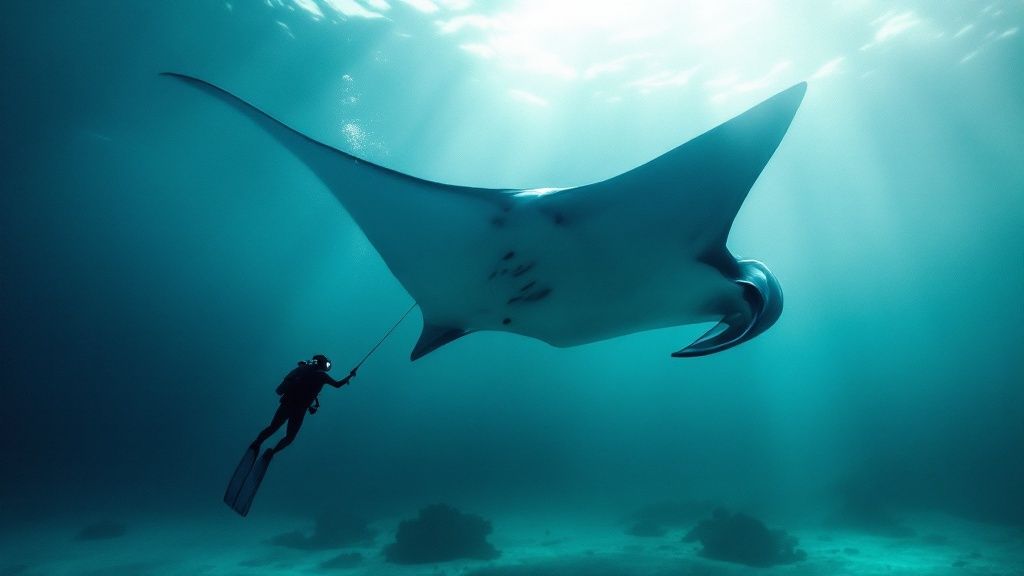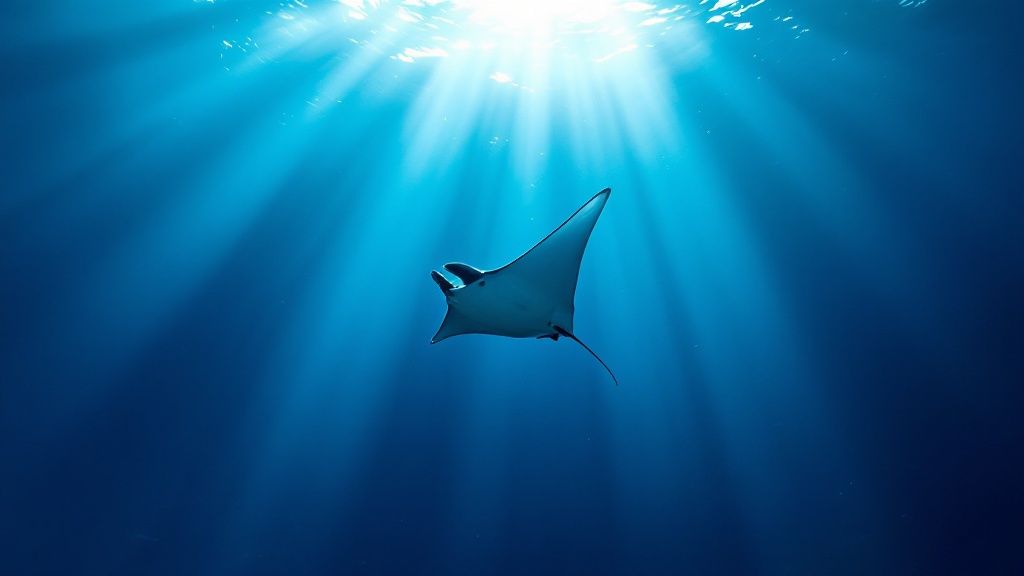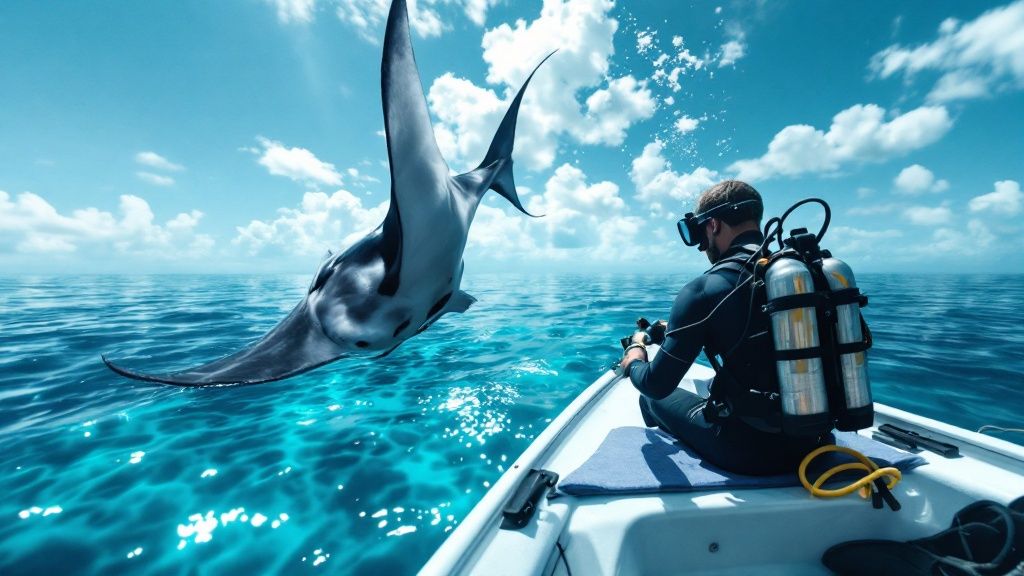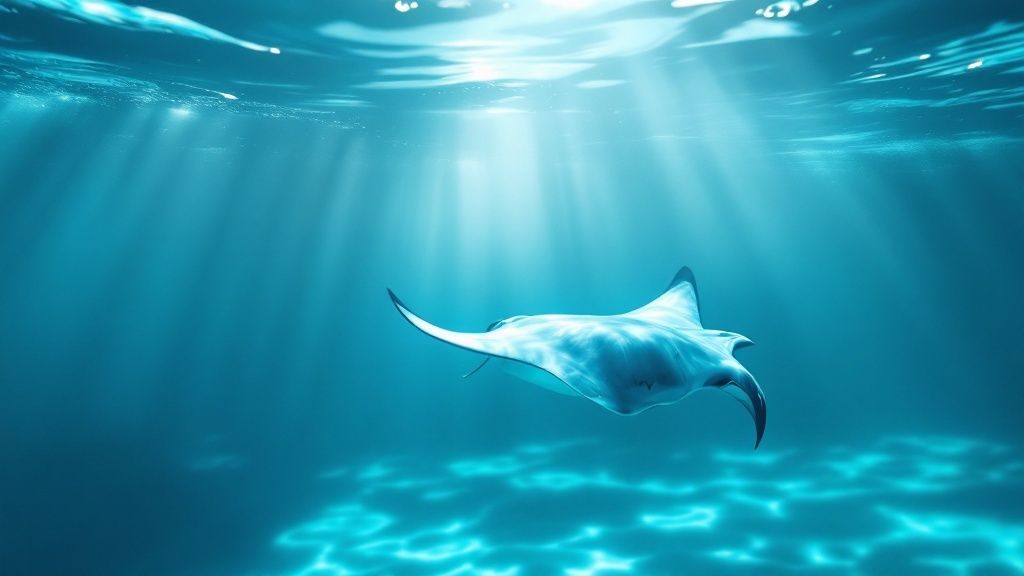The Magic of Manta Ray Diving on Hawaii's Kona Coast
There's something truly captivating about observing manta rays in their natural environment. The Kona Coast of Hawaii's Big Island offers a remarkable opportunity to witness this, drawing divers and snorkelers alike. It provides an unparalleled vantage point for observing these gentle giants. But what makes this location so special?
The Kona Coast: A Manta Ray Paradise
The secret lies in the Kona Coast's distinct volcanic landscape. Nutrient-rich volcanic runoff creates the perfect environment for plankton blooms, the manta ray's main food source. These consistent blooms ensure that mantas are present year-round, providing reliable sightings for those eager to observe their fascinating feeding habits. This predictability makes the Big Island a top manta dive spot, attracting enthusiasts worldwide. Explore the beauty of manta ray encounters along the Kona Coast with a manta ray swim Kona Hawaii adventure.
The Big Island is famous for its manta ray diving, particularly at Manta Village and Manta Heaven. These locations offer a high probability of spotting manta rays, with sightings occurring on approximately 80% to 90% of night dives. The plentiful plankton draws these graceful creatures to these areas. Dive operators like Jack's Diving Locker report frequent encounters, solidifying the Big Island as an ideal destination for manta ray lovers. The consistent presence of mantas year-round contributes to the popularity of these dives, with an average of six mantas sighted per night, and sometimes as many as 36 on exceptional evenings. More detailed statistics can be found here.
A Truly Unforgettable Experience
A manta ray dive on the Big Island is a deeply moving experience. Picture yourself floating in the dark, illuminated by underwater lights, as these magnificent creatures, with wingspans reaching up to 14 feet, glide beneath you. They execute complex barrel rolls, appearing to dance in the light beams as they feed on plankton. This "manta ray ballet" is a breathtaking display that creates a lasting memory for all who witness it. A manta dive on the Big Island isn't just a dive; it's a powerful connection with the ocean's wonders.

This experience offers more than just a thrilling encounter. It cultivates a deep appreciation for these remarkable animals and the crucial importance of their conservation. The magic of manta ray diving on the Big Island comes from this unique combination of adventure and awareness, resulting in a truly remarkable experience.
Prime Manta Dive Locations: Finding Your Perfect Encounter
Not all manta ray dive sites on the Big Island offer the same experience. Two locations, Manta Village (Kaukalaelae) and Manta Heaven (Keauhou Bay), are exceptional spots for encountering these gentle giants. Knowing the differences between these locations can help you plan the perfect manta ray dive.
Manta Village: The Original and Reliable Choice
Located off Keauhou, Manta Village is considered the original manta ray night dive site. It boasts an incredibly high success rate for manta ray sightings. In one study, 96% of tours at Manta Village reported seeing manta rays, with an average of four mantas per night. This reliability makes it a great choice for visitors with limited time. Some operators even depart directly from Keauhou Bay, minimizing travel time and lessening the chance of seasickness.
Manta Heaven: A Spectacle of Numbers
Manta Heaven, near the Kona International Airport, is known for its large numbers of manta rays. While the sighting success rate is slightly lower than Manta Village (around 90%), the average number of mantas seen per dive is much higher. This means there's a marginally higher chance of not seeing any mantas, but successful dives here often lead to incredible encounters with many of these graceful creatures. This abundance makes Manta Heaven exciting for experienced divers looking for an unforgettable experience.
Emerging Spots and Intimate Encounters
Besides these two popular locations, other dive spots on the Big Island offer more intimate encounters with fewer people. These less-visited sites provide unique views and a closer connection to the marine environment. While they may not have the consistent sighting rates of Manta Village or the sheer number of mantas at Manta Heaven, they offer a more personal and peaceful dive. This growing interest in alternative locations also helps reduce the impact of tourism on the manta rays and their habitats. Dives off the Kohala Coast near Waikoloa, for instance, offer smaller groups and the chance for a truly special, quiet encounter.
To help you choose the dive site that's right for you, we've put together a comparison table highlighting the key features of each location:
Big Island Manta Ray Dive Sites Comparison: A comparison of the main manta ray dive locations on the Big Island, highlighting key features and practical information for each site.
| Site Name | Location | Dive Type | Average Depth | Best Time | Success Rate | Crowd Level |
|---|---|---|---|---|---|---|
| Manta Village | Keauhou | Night | 30-40ft | Sunset-Night | 96% | High |
| Manta Heaven | Keauhou Bay | Night | 30-40ft | Sunset-Night | 90% | High |
| Kohala Coast | Waikoloa | Night/Day | Varies | Varies | Lower but increasing | Low |
This table provides a quick overview of the main differences between the dive sites, allowing you to weigh factors like success rate, crowd levels, and dive type when making your decision. Remember to factor in your experience level and what kind of encounter you are hoping for.

Night vs. Day Manta Dives: Timing Your Perfect Encounter

The time of day you choose for your manta ray dive on the Big Island dramatically shapes your experience. Daytime dives provide opportunities to observe these gentle giants in their natural environment, but night dives offer a truly unforgettable spectacle. The key to understanding this difference lies in the manta rays' feeding habits and their interaction with light. Planning the best possible manta dive big island experience hinges on understanding these behaviors.
The Manta Ray Ballet: A Nighttime Spectacle
After sunset, the plankton manta rays consume are attracted to the surface by dive lights. This creates a captivating natural phenomenon often called the "manta ray ballet." As the plankton gather, the mantas perform elegant loops and barrel rolls, feeding on the tiny organisms. They seem to dance in the underwater lights, creating a hypnotic display for divers. This remarkable feeding behavior is seldom witnessed during daylight hours, highlighting the unique appeal of night dives.
Daytime Encounters: A Different Perspective
During the day, you might spot manta rays gracefully gliding through the ocean or frequenting cleaning stations, where smaller fish remove parasites. While these daytime sightings can be rewarding, they lack the concentrated feeding activity and dramatic lighting of a night dive. If your main objective is to witness the iconic manta ray feeding frenzy, a night dive is the preferable option.
Overcoming Night Dive Apprehension
Some divers might feel apprehensive about venturing into the ocean at night. However, with proper preparation and guidance from experienced dive operators, night dives can be incredibly safe and rewarding. Many dive operators specialize in making first-time night divers feel at ease. This support helps alleviate anxiety, allowing divers to fully immerse themselves in the magical experience. Focusing on the mantas also creates a calming effect, minimizing any potential fear of the dark.
Manta ray sightings along the Kona Coast are generally consistent, but they are also heavily influenced by environmental conditions like moon phases and plankton availability. On darker nights, manta ray activity tends to increase substantially as they engage in more active feeding. Organizations like Manta Ray Advocates Hawaii have meticulously documented these patterns. From 2009 to 2014, they collected comprehensive data at popular dive sites like Manta Village and Manta Heaven, revealing valuable insights into manta ray behavior and population dynamics. This research emphasizes the intricate relationship between the mantas and their environment, enriching the manta dive big island experience.
Capturing the Magic: Photography Tips
Capturing photos of these magnificent creatures, whether during the day or night, requires specific techniques. Night dives present the challenge of low-light conditions. A high-quality underwater camera with a powerful flash is essential. Adjusting your camera settings to capture the mantas' movement without blurring is also crucial. This preparation helps preserve the memory of your manta dive big island adventure. During the day, natural light improves visibility, simplifying photography. However, a polarizing filter can reduce glare and enhance the colors of the manta rays and the surrounding coral.
Selecting Your Manta Dive Operator: Beyond the Basics

Picking the right manta ray dive operator for your Big Island adventure is essential for an unforgettable experience. While price is definitely a consideration, other factors significantly influence the quality of your dive. Focusing only on the cheapest option might leave you wishing you'd explored further. We're here to help you make the best choice.
Evaluating Operator Expertise and Commitment
The best manta ray dive operators offer more than just a boat ride. They understand the importance of marine conservation and strive to educate guests about these graceful creatures. Operators with certified marine naturalists on board can provide fascinating insights into manta ray behavior, biology, and the delicate ecosystem they inhabit. This added educational element enriches the whole dive experience and cultivates a deeper respect for the marine environment.
Look for operators committed to sustainable practices, such as encouraging the use of reef-safe sunscreen and minimizing disruptions to the manta rays’ natural habitat. This kind of responsible ecotourism benefits everyone.
Assessing Vessel Quality and Group Management
Your dive experience is greatly affected by the vessel itself. A comfortable, well-maintained boat contributes to a relaxing and enjoyable trip. This is especially important for night dives and longer excursions. Think about features that enhance comfort and convenience, like ample deck space, easy water entry and exit points, and warm drinks available on board.
Group management is another crucial aspect. Responsible operators keep group sizes small. This allows for more personalized attention from the guides and minimizes disturbance to the manta rays.
Understanding the Needs of Different Divers
Different operators cater to varying experience levels, from beginners taking their first underwater breaths to seasoned divers looking for a challenge. Some specialize in introductory dives, offering gentle guidance and support to newcomers. Others might focus on advanced techniques or provide specialized setups for underwater photography. Consider your own diving experience and choose an operator that meets your specific needs and interests.
Premium pricing isn't always a bad thing. It might reflect specialized services like dedicated photo guides, customized equipment, or extended dive times. It's important to understand what you're paying for and how it enhances your overall experience.
To help you compare different operators, we've compiled a table highlighting key features and services:
Big Island Manta Dive Operators Comparison
A detailed comparison of the top manta ray dive operators on the Big Island, including services, specialties, and customer ratings
| Operator Name | Location | Group Size | Price Range | Equipment Quality | Conservation Focus | Beginner-Friendly Rating |
|---|---|---|---|---|---|---|
| Kona Honu Divers | Kona | Small | $$$ | Excellent | High | 5/5 |
| Big Island Divers | Kona | Medium | $$ | Good | Medium | 4/5 |
| Manta Ray Dives of Hawaii | Keauhou | Large | $ | Fair | Low | 3/5 |
| (This is example data, please fill in real data) | — | — | — | — | — | — |
This table provides a quick overview of several operators, allowing you to easily compare factors like group size, price range, and commitment to conservation.
Asking the Right Questions and Identifying Red Flags
Before you book, don't hesitate to ask potential operators specific questions to gauge their expertise and practices. Here are some important ones to consider:
- What is their group size policy?
- Do they have certified marine naturalists on staff?
- What are their safety protocols?
- What is their manta ray interaction policy (e.g., no touching)?
- Do they actively participate in conservation efforts?
Be cautious of operators who guarantee sightings. While manta ray encounters are frequent on the Big Island, they are wild animals, and sightings can never be truly guaranteed. Unrealistic promises can be a red flag. Kona Honu Divers prioritizes responsible interactions and sustainable practices, ensuring a high-quality Big Island manta ray dive experience. We invite you to explore our manta ray night dive offerings and discover the magic of these gentle giants.
Snorkel Vs. Scuba With Mantas: Choosing Your Perspective
Visiting the Big Island and wondering how to best experience its majestic manta rays? Many visitors find themselves deciding between snorkeling and scuba diving. Both offer unique perspectives, and the ideal choice depends on your individual comfort in the water, budget, and the kind of encounter you’re hoping for. Let's explore the different experiences each option provides to help you choose the best manta dive big island adventure for you.
Snorkeling With Mantas: A Panoramic View
Snorkeling offers a surface perspective, allowing you to observe the mantas' impressive size and graceful movements from above. Floating on the surface, you'll typically hold onto a flotation device equipped with lights. These attract plankton, which in turn draw the mantas closer.
This creates a captivating spectacle often referred to as the "manta ray ballet," as the mantas perform barrel rolls and loops just below you. Snorkeling is generally less expensive than scuba diving and requires less equipment and training. This makes it an attractive choice for families and those new to water activities. Furthermore, the popularity of manta ray night snorkeling has increased significantly, especially with growing awareness surrounding responsible interactions with marine life. Learn more about the popularity of night snorkeling.
Scuba Diving With Mantas: An Immersive Encounter
Scuba diving provides a completely immersive experience. Descending to the ocean floor, you'll watch the mantas glide overhead. This unique vantage point allows for a closer, more intimate view of these gentle giants. You'll be able to appreciate their intricate details and powerful presence in a way snorkeling simply can't provide.
While scuba diving requires certification and specialized equipment, the experience of being surrounded by these incredible creatures in their natural environment is truly memorable.
Factors to Consider: Beyond the View
Several practical considerations can influence your choice. Cost is a key factor, with scuba diving generally being more expensive due to equipment rentals and certification requirements. Physical limitations may also influence your decision. Scuba diving requires a certain degree of physical fitness and comfort underwater, while snorkeling is typically more accessible.
Finally, consider your photography goals. If you’re a keen underwater photographer, scuba diving can offer better opportunities for capturing stunning close-ups. Snorkeling, on the other hand, can provide wider, more panoramic shots.
Choosing the Right Fit: Your Manta Ray Adventure
The best way to choose between snorkeling and scuba diving with mantas is to consider your own preferences and priorities. If you're looking for a budget-friendly, accessible, and panoramic view, snorkeling is an excellent option. If you're looking for a more immersive, close encounter and are comfortable with the additional cost and training, scuba diving might be ideal.
Both experiences offer an amazing chance to witness these magnificent creatures in their natural habitat, creating lifelong memories of your manta dive big island adventure. With Kona Honu Divers, you can find high-quality options for both snorkeling and scuba diving, ensuring a remarkable manta ray encounter tailored to your preferences. Explore our manta ray night dive and snorkel offerings.
Conservation in Action: Protecting Hawaii's Manta Treasures
Your manta dive big island experience is more than just an adventure; it's a chance to contribute to vital conservation efforts. By participating in these dives, you're directly supporting the ongoing work to study and protect these magnificent creatures.
Photo Identification: Tracking Mantas Over Time
One of the most effective ways researchers monitor manta rays is through photo identification. Much like human fingerprints, the unique spot patterns on a manta's underside allow scientists to identify and track individuals over decades. Organizations like the Manta Pacific Research Foundation use these photos to build comprehensive databases, offering valuable insights into manta ray population dynamics, migration patterns, and individual life histories. This long-term monitoring is crucial for understanding how manta populations are affected by environmental changes and human activity.
This research helps determine if individual mantas are returning to the same feeding grounds year after year and if environmental shifts impact their presence. Amazingly, your own underwater photos can contribute to this research! By submitting clear images of manta ray bellies to these programs, you become a citizen scientist, directly aiding the ongoing study and protection of Hawaii's mantas. Imagine your vacation photos helping researchers track a manta's movements and health throughout its lifetime.
Threats to Hawaii's Mantas: Understanding the Challenges
Hawaii's manta rays face numerous threats, and understanding these challenges is essential for effective conservation. Fishing gear entanglement, even unintentional bycatch, is a major concern. Manta rays can become entangled in nets and lines, leading to injury or death.
Habitat degradation and climate change also pose significant risks. Changes in ocean temperature and acidity can affect plankton availability, the mantas' primary food source. This disruption to the food chain impacts the entire ecosystem, including the manta ray population. These factors underscore the interconnectedness of the marine environment and the need for comprehensive conservation strategies.
Responsible Operators: Choosing Conservation-Minded Dives
Many manta dive big island operators actively participate in conservation initiatives, prioritizing sustainable practices that minimize disturbance to the manta rays and their habitat. Look for operators who adhere to responsible guidelines, such as limiting group sizes, maintaining a respectful distance from the mantas, and educating divers about proper interaction protocols.
Choosing a conservation-minded operator ensures your dive benefits, rather than harms, these magnificent creatures. This support encourages other operators to adopt similar practices, further protecting Hawaii's manta ray population.
Supporting Manta Welfare: Practical Guidelines for Divers
As a diver, you play a critical role in manta ray conservation. Here are some guidelines to ensure your encounter benefits these gentle giants:
-
Maintain a Respectful Distance: Avoid touching manta rays. Their skin is covered with a protective mucus layer easily disrupted by human contact.
-
Do Not Chase or Harass Mantas: Allow them to approach you naturally, and resist the urge to follow them closely.
-
Control Your Buoyancy: Avoid kicking up sand or stirring the bottom, which can disrupt their feeding and potentially harm their delicate gill structures.
-
Follow Your Guide's Instructions: Experienced guides understand manta ray behavior and can facilitate a safe and rewarding encounter while minimizing disturbance.
By following these guidelines, you can help protect these incredible animals for future generations. Your manta dive big island excursion can be both a thrilling adventure and a meaningful contribution to their conservation. Experience the magic of manta rays while supporting their preservation. Book your unforgettable manta ray night dive with Kona Honu Divers today! Explore our manta ray night dive offerings.
